(NEP) Communication SKILL BBA I YEAR NOTES ALL UNIT: is defined as “The flow of material information perception, understanding and imagination among various parties”.

Communication SKILL BBA 1 YEAR NOTES ALL UNIT
Subject – Communication Skill
| UNIT – I | Definition and Process of Communication. Essential of Effective communication. Barriers to Communication. Role of Communication in Organizational Effectiveness. |
| UNIT – II | Public Speech: Com Position, Principles, Speech Delivering Skills, Group Discussion, Do‟s and Don‟t‟s of GD‟s Communication in Committees, Seminars and Conference. |
| UNIT-III | Non Verbal Communication : Meaning, Types and Importance. Listening : Difference between Listening and Hearing. |
| UNIT – IV | Drafting of Notices, Agendas, Minutes, Job Application Letters preparation of Curricular Vitae. |
| UNIT – V | Business Correspondence essentials of Effective Business Correspondence, Structure of Business Letter Types of Business Letter- Enquiry, Reply, Orders, Complaints, Circular Letter. |
UNIT -I
Communication is defined as “The flow of material information perception, understanding and imagination among various parties”.
Meaning: Communication is the process of passing information and understanding from one person to another to bring about commoners of interest, purpose and efforts communication as not complete unless the receiver of the message has understood the message properly and his reaction or response is known to the sender.
Share: WHATSAPP And Facebook
DEFINITION: According to Neaman and Summer communication is defined as “an exchange of facts, ideas, opinions (or) emotions by two or more persons’’.
According to Charless E Redfield “communication is the bread field of human interchange of facts and opinions and not the technologies of telephone, telegraph, radio etc”.
According to the Keith and Gulcllini, communication is defined as “In its Everyday meaning, communication refers to the transmitting of information in the form of words or signals or signs from a source to a receiver”.
Business includes those organizations, which are engaged in the production and distribution of goods and services to earn profit. Therefore Business communication means, “Flow of information, perception etc. either within a business organization or outside the organization among different parties”.
Communication plays an important role in business organization. The success of an enterprise depends upon the effectiveness of communications, it is said to be the new system of the enterprise. Nothing happens in business until communication takes place. Every manager must communicate, in order to get things done through others. It has few established that manages spend about 75% to 95% of the working time in communicating with others. Communication is as indispensable for all meaning and controlling.
We can extract the following points from the above definition;
- Flow between two or more parties. In business communication the material flow from one person to another person or from many persons to different people. This flow may either be inside the organization or outside the organization.
- Flow of information, perception, imagination etc. Flow of information takes place when a party transfers the material to another mind. For example, when a news caster says, “India has conducted nuclear test on 28th May 1998”. This is a flow of information from news caster to the listeners. Flow of perception means transfer of different feelings. Finally, flow of imagination that occurs when a painter conveys his/her imaginations through a portrait.
ROLE OF EFFECTIVE BUSINESS COMMUNICATION WITHIN AND OUTSIDE THE ORGANIZATION
Business Communication is called, “Life blood” of an Organization. A business Organization is a group of people associated to earn profit. Various kinds of activities have to be performed by the people of an organization so as to earn profit. These activities need an effective and systematic communication. Without efficient communication, one cannot even imagine to do work and hence will be unable to earn profit. Since the aim of business organization is to earn profit, the organization will die without profit and this death is a result of the absence of communication. This is why communication is called life blood of a business organization. We can prove this statement in the following manner.
COMMUNICATION INSIDE AN ORGANIZATION:
Different employees and officials in an organization need to communicate to each other. This internal communication with its importance is shown in the following way:
1. Setting goals and Objectives:-
Mostly, the organizations have a variety of formal and informal objectives to accomplish. These objectives may be financial results, product quality, market dominance, employees satisfaction, or service to customers. So the communication enables all the persons in an organization to work towards a common purpose.
2. Making and Implementing decision:-
In order to achieve the objective, people in a business organization collect facts and evaluate alternatives, and they do so by reading, asking questions, talking or by plain thinking. These thoughts are put into a written form. Once a decision has been made, it has to be implemented which requires communication.
3. Appraisal:-
Having implemented the decision, management needs to determine whether the desired outcome is being achieved. Statistics on such factors as cost, sales, market share, productivity and inventory levels are compiled. This is done through computers, manual papers, memos or reports.
4. Manufacturing the products:-
Getting an idea for a new product out of someone‟s head, pushing it through the production process and finally getting the product also require communication. Designing the plan regarding product, introducing the workers, purchasing raw material, marketing and distributing the product all require effective communication.
5. Interaction between employer & employee:-
Employees are informed about policies and decisions of employers through circulars, reports, notices etc. Employers also get in touch with employees through application, complaint etc. So, communication plays a vital role in the interaction of employer and employee.
Read Also
EXTERNAL COMMUNICATION:
Hiring the employees:-
If a company wants to hire someone, it advertises the vacancy, receives applications, calls the candidates, takes the interview and then offers job to the successful candidates. The whole process requires communication.
2. Dealing with customers:-
Sales letters and brochures, advertisements, personal sales calls, and formal proposals are all used to stimulate the customer‟s interest. Communication also plays a part in such customer related functions as credit checking, billing, and handling complaints and questions.
3. Negotiating with suppliers and financiers:-
To obtain necessary supplies and services, companies develop written specification that outlines their requirement. Similarly, to arrange finance, they negotiate with lenders and fill out loan applications.
4. Informing the investors:-
Balance sheet, income statement, and ratio analysis are used to inform the investors regarding performance of business.
5. Interacting with Govt.:-
Government agencies make certain rules to regulate the economy. These rules are communicated to organizations through various papers. These organizations try to fulfill, these requirement like filling taxation form and other documents.
- (PDF) R Gupta’s Popular Master Guide For CUET UG All Subjects Latest Edition – Free PDF Download
- Insights IAS Mains 2022 Test 3 With Explanation Free PDF Download
- Insights IAS Mains 2022 Test 2 With Solution Free PDF Download
IMPORTANCE OF COMMUNICATION FOR AN INDIVIDUAL (Manager) AND FOR AN ORGANIZATION COMMUNICATION:-
Definition: “Communication is the process by which information is transmitted between individuals and organization, so that an understanding response results”.
OR
“Communication is the process which involves transmission and accurate replication of ideas, ensured by feedback for the purpose of eliciting action which will accomplish organizational goals”.
IMPORTANCE OF COMMUNICATION FOR A MANAGER
Helps in getting a desired job:-
Getting a desired job is not an easy task. It requires a person to be excellent, especially in terms of communication abilities. Communication abilities can be classified into five categories that is reading, writing, speaking, listening and observing.
If a candidate is a good reader of not only text books and reference books but also of newspapers and magazines, this would help him developing confidence level at the time of interview. Writing skills are necessary for preparing an appropriate
Biodata and covering letter, so that a better initial impression could be created. No doubt, conversational skill right at the time of interview is equally countable towards success of the candidate. Listening abilities on the other could prove to be fruitful especially when the interviewer
is making a comment or asking a question. In short we can say that the presence of above mentioned five communication skills could give a better chance of being selected during an interview.
(2) Help in maintaining social relationships:-
We as human beings live in a cobweb of relationships rather social relationship. These social relations compel us to act simultaneously in the capacity of father, child, husband, uncle, neighbour, cousin, teacher, nephew and so on. All these relationships especially near one‟s could be maintained properly if we can communicate well to all these relations, that we are here to take care of them and our services are always there to help them in case of any needs.
(3) Helps in getting on the job promotion:-
Perhaps finding a job would not be a big deal in case of if the candidate is well connected and belongs to a well off family. But promotion on the job requires some extra skills on the part of the candidate. Amongst those skills, communication abilities rank on the top. If a person can speak well during interactive and presentation sessions, can reports properly, he will automatically be in the eyes of the management and whenever a chance for promotion comes, he will be on the top of the list.
(4) Helps in solving other’s problems:-
It is commonly observed that around us there are so many people whom we like to meet, their company is a source of enrichment for us. When we are with them we feel secured. The only reason for such types of feelings is that such type of people are not only good listeners but they also know it well that whenever they would speak, it would only be for the sake of encouraging, not discouraging others, only for solving other‟s problems and not for creating problems for others. Such people are no doubt excellent communicators.
DIFFERENTIATE BETWEEN FORMAL AND INFORMAL LANGUAGE;
Formal language: Informal Language:
- It is the language spoken in office, business and other formal places.
- Proper and standard words are used.
- It consists of specific purpose words like manager, supervisor, owner, employer etc.
- It is used comparatively less than informal language.
- It is used when the speaker is relaxed.
Read Also:
- [PDF] BANSAL Classes PCM Module and All Sheets FOR IIT JEE Free Pdf Download
- Arihant Class 12 Term 2 Science Stream Sample Question Papers All Subjects – Free PDF Download
- (PDF) Arihant 20 Years Chapterwise Topicwise JEE Main Solved Papers PCM Free PDF Download
PROCESS OF COMMUNICATION
“Communication is a two way process of exchanging ideas or information between two human beings”.
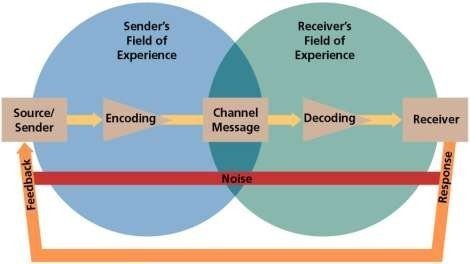
Communication simply means exchange of ideas & information between two persons. A person sends a message to another person and gets the response from the receiver on the message. This whole phenomenon can be explained as under.
1. Sender’s thoughts:-
The very first step in the process of communication is generation of thought in the sender‟s mind. These thoughts may be about a request, order, inquiry production or any other such activity.
2. Encoding / Message:-
The thought generated in the mind of sender is ambiguous and unable to be communicated unless it is put into a receivable form. This step is known as encoding where the sender converts his thought into a message by means of a language. For example, a sender thinks about having a job. Now, he will put his thought on a paper. That is called job application. In his way, his thought becomes a message.
3. Transmission through media:-
Once a thought is converted into message, it should be transmitted to the receiver through a suitable medium. This media might be electronic media as T.V., E-mail, radio etc. or it may be print media like newspaper, magazines, letters or merely sound that is transmitted through the medium fair.
4. Noise and Barriers:-
While transmitting the information to the receiver, the sender faces lots of barriers. These noise and barriers are explained as under:
- On sender’s side:- Noise and barriers may take place during the process of encoding. Some of them may be caused by distraction, lack of concentration, typing mistake, poor language etc.
- In the medium:- Some barriers are caused by medium such as poor transmission on T.V. and radio misprinting in newspapers etc.
- On receiver’s side:- The receiver can also create certain barriers to the receiving of message such as poor reading ability, emotions, lack of concentration etc.
5. Decoding by Receiver:-
Having received the message from the sender, the receiver attempts to understand and interpret the message. This process of converting the language of message into thoughts is known as decoding. For instance, the receiver, having received job application, reads the application and understands the message conveyed by the applicant.
6. Idea Received:-
As soon as the process of decoding is finished, the idea given by the sender is received by the receiver. It means the thought that was generated in the mind of sender has been transmitted to the mind of receiver. In our example, the sender wanted to inform the receiver about his thought of having a job. Now the sender has got this idea.
7. Feed back:-
Process of communication is incomplete until the receiver responds to the sender. This response may be negative, positive, or for further enquiry. It means when the receiver of job application welcomes or regrets the sender, the process of communication is deemed to be complete.
FIVE ELEMENTS (FACTORS) OF THE PROCESS OF COMMUNICATION:
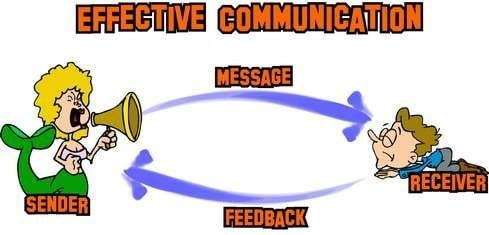
Communication is the exchange of ideas between two minds. This process of exchanging idea is based on following five factors.
1. Sender:-
Sender is the person who initiates the process of communication. He generates an idea in his mind regarding production invention, innovation, request, order, enquiry etc. So, he is the first factor of communication process and his function is to generate an idea. Therefore, it is necessary that the idea should be clear, and convertible into message. For this purpose, the sender needs to apply his knowledge and imaginative power.
2. Message:-
The idea in the mind of sender is transformed into words that is called message. The sender decides on the length, style, organization and tone of the message. The message may be presented in many ways, depending on the subject, purpose, audience, personal style, mood and cultural background.
3. Media:-
The media of transmission of message are electronic media as T.V., radio, computer and print media as newspapers, letter, magazine etc. media play a very important role in helping the receiver‟s understand the message. A wrongly chosen medium can interrupt the process of communication, Selection of medium depends upon message, audience, urgency and situation.
4. Receiver:-
Receiver is the person who gets the message from the sender, decodes it, understands it and interprets it.
5. Feed Back:-
Having understood the message, the receiver responds to the sender in yes or no or asks further questions. This process is called feedback.
VERBAL COMMUNICATION
VERBAL COMMUNICATION: Verbal communication means such a communication that takes place by means of a language or words”. It includes the following contents.
Read Also:
- CBSE Class 12 Xam Idea Term 2 Books Free Pdf Download
- (PDF) Pradeep Chemistry Class 11 Full Book Free Pdf Download 2022-23
- Together with Science Class 10 Question Bank Free Pdf Download
Oral communication (Speaking & listening)
- Written communication (writing & reading)
1. Speaking:-
In order to send message in business, speaking plays a vital role. Giving instruction, conducting interviews, attending meetings, sending orders through telephone calls are very common in today‟s business.
2. Writing:-
It is used when a complex message is sent. Placing order through letters, informing employees through circulars, sending reports and memos, filling different government forms, keeping records in writing are some examples of this aspect of verbal communication.
3. Listening:-
People in business spend more time in obtaining information then transmitting it. Listening is the most important way to receive information: information regarding order of employers, instruction, rules and regulation, customer trend etc, are obtained through listening. But in listening, people generally forget 75% of the message after few days.
4. Reading:-
Reading reports, memos, policies, circulars, and different business statements are essential for an organization: Reading involves understanding and interpreting the material.
Channel of Communication
Meaning – „Channel‟ refers to that path through which information passes or flows from one person to another.
Communication channel are established by the organization and are accepted & recognized by employees & managers. Every organisation has to adopt two communication processes- internal and external.
External communication-
Communication with those outside the organization is known as external communication.
- Outward- the messages which go out of the organization to customers, suppliers, banks, insurance companies, govt. departments, mass media & the general public. They may be in the form of letters, faxes, banners, reports, telegrams, advertisements, press handouts, speeches, visits, trade fairs, etc.
- Inward – messages that are received from outside by the company. An organization may receive letters, faxes, telegrams, telephone calls, personal visits, magazines, etc. these may be from customers, suppliers, other organization, govt. departments, etc.
Internal communication-
The communication within the organization, among its members is internal communication
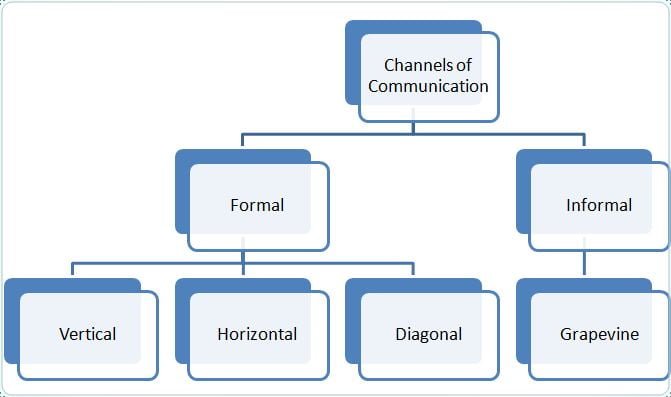
Channels of Communication
- Formal channel – the communication when takes place within the official i.e. the lines of communication is approved by senior management. This is the channel which carries the official messages in the organization.
Under a formal channel-
- There are efforts made by each & every individual at various levels.
- The most important aspect of formal channel is that no level of the organization is overlooked or bypassed. The information passes through an already fixed, systematic channel.
- It is the process or sharing official information with others who need to know it, which is according to the prescribed patterns depicted in an organization‟s chart.
Formal communication is done through-
Company newsletters, employee handbook, company magazines, formal meetings, letters, bulletins, memos, faxes, all-employees mailing, etc.
Formal channels includes-
- Vertical communication
- Downwards communication: When the instructions & directions flow form the top level to the bottom level i.e. from superior to the subordinates. These are in written forms-
- Upwards communication: The information which flows upwards in the form of feedback i.e. from subordinates to superior. These may be oral or
written.
- Horizontal or lateral communication: When communication flows between the employees of the same level of different departments.
Diagonal: the transfer of information between people who are neither in the same department nor on the same level of organization hierarchy is called diagonal communication. For example: when the assistant marketing manager communicate with account clerk directly.
(b) Informal channels –
The informal channel of communication may be defined as passing information outside the official channels, for e.g.:- employees chatting in the canteen or pub. It can affect the future of the business, particularly if the formal system has broken down.
- Grapevine is an informal channel of communication.
- Primarily a channel of horizontal communication, it can flow even vertically and diagonally.
- Grape vine- If communication is done without maintaining the formalities prescribed by the organization, it is called informal communication. The basis of informal communication is personal or informal relationship between the members of a group. It is also known as grapevine that takes place when the people of an organization or group, especially of same level or rank gather or meet tighter and discuss informally. It has no definite pattern or direction though it is largely horizontal in nature. It is a complex web of oral information flow linking all the members of the organization. Definition of Grapevine Communication, Meaning of Grapevine Communication,
- It forms a lease of informal relation between two or more Individuals
- It is not planned & organized.
- It may be both official and personal.
- It is based on friendship or acquaintances.
Definition :- According to Bovee and Others, “Grapevine is an informal interpersonal channel of information not officially sanctioned by the organization.
In the opinion of R.W. Griffin, “The grapevine is an informal communication network that can permeate an organization.”
Newstrom and K. Davis said, “Grapevine is an informal system that arises spontaneously from the social interaction of the organization.” Business Communication
Patterns or Types of Grapevine :- The grapevine does not have any definite pattern or direction, though it is largely horizontal in nature. It can be effective horizontally, vertically and even diagonally. Prof. Keith Davis, who has done some research work on the nature of grapevine, has classified it into four basic types-
Four major patterns of grapevine:-
- Single Strand Chain: The single strand chain involves the passing of information through a line of persons to the ultimate recipient. In the figure, the person A tells B, who tells C, who tells D, and so on, till the information has reached most of the persons involved or concerned.
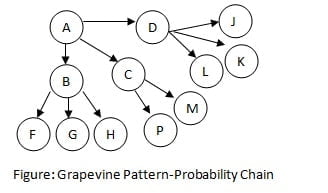
- Gossip Chain: In the gossip chain, one person seeks and tells the information to everyone. This chain is just like the wheel where one person stays at the centre and the information passes along the spokes of the wheel to others stationed on the rim. In the following figure, A is at the center and passes the information to others staying on the rim of the wheel.
- Probability Chain: The probability chain is a random process in which someone transmits the information to others in accordance with the laws of probability and then these others tell still others in a similar way. This chain may also be called random process. The probability chain is shown below-
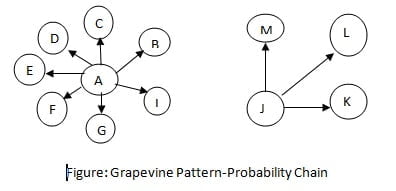
- Cluster Chain: In the cluster chain, a person tells the information to the selected persons who may in turn relay (pass) the information to other selected persons. Most of the information communication follows this chain. Cluster chain is shown in the following figure-
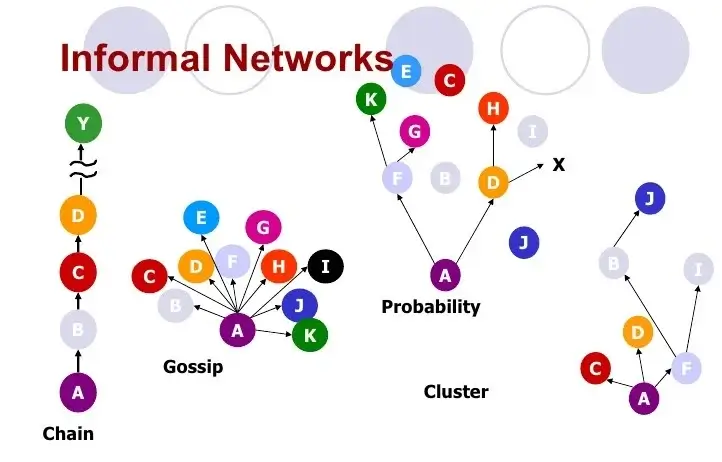
Advantages of Grapevine Communication
- Grapevine channels carry information rapidly. As soon as an employee gets to know some confidential information, he becomes inquisitive and passes the details then to his closest friend who in turn passes it to other. Thus, it spreads hastily.
- The managers get to know the reactions of their subordinates on their policies. Thus, the feedback obtained is quick compared to formal channel of communication.
- The grapevine creates a sense of unity among the employees who share and discuss their views with each other. Thus, grapevine helps in developing group cohesiveness.
- The grapevine serves as an emotional supportive value.
- The grapevine is a supplement in those cases where formal communication does not work.
Disadvantages of Grapevine Communication
- The grapevine carries partial information at times as it is more based on rumours. Thus, it does not clearly depicts the complete state of affairs.
- The grapevine is not trustworthy always as it does not follows official path of communication and is spread more by gossips and unconfirmed report.
- The productivity of employees may be hampered as they spend more time talking rather than working.
- The grapevine leads to making hostility against the executives.
- The grapevine may hamper the goodwill of the organization as it may carry false negative information about the high level people of the organization.
Barriers Of Communication
Introduction – No matter how good the communication system in an organization is, unfortunately barriers can and do often occur. This may be caused by a number of factors which can usually be summarized being as due to physical barrier, languages, organizational, emotional, personal barriers.
A communication becomes successful only if the receiver understands what the sender is trying to convey. When your message is not clearly understood, you should understand that your message is facing a barrier.
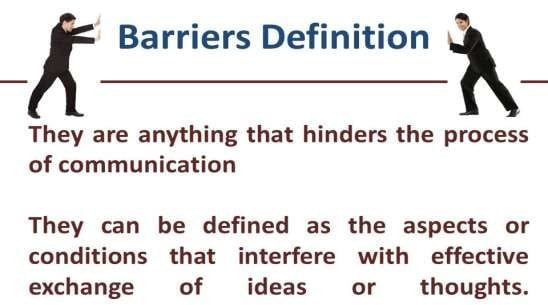
Commonly Experienced Barriers
- Noise
- Lack of planning
- Wrong & unclarified assumption
- Culture
- Social –psychological barriers
- Emotions
- Filtering information
- Loss by transmission
- Goal conflict
- Offensive style
- Time & distance
- Improper Time
- Physical Distance
- Information Overload
Linguistic Barriers
The language barrier is one of the main barriers that limit effective communication. Language is the most commonly employed tool of communication. The fact that each major region has its own language is one of the Barriers to effective communication. Sometimes even a thick dialect may render the communication ineffective.
As per some estimates, the dialects of every two regions changes within a few kilometers. Even in the same workplace, different employees will have different linguistic skills. As a result, the communication channels that span across the organization would be affected by this.
Thus keeping this barrier in mind, different considerations have to be made for different employees. Some of them are very proficient in a certain language and others will be ok with these languages.
Read Also:
- Class 11 JEE – NEET – Books, Notes, & PYQs PDF Free Download
- Class 9 Science Notes PDF Free Download. All Chapters Question Answers.
- Neet Study Material Books Notes Video E-Books Free Pdf Download
Psychological Barriers
There are various mental and psychological issues that may be barriers to effective communication. Some people have stage fear, speech disorders, phobia, depression etc. All of these conditions are very difficult to manage sometimes and will most certainly limit the ease of communication.
Emotional Barriers
The emotional IQ of a person determines the ease and comfort with which they can communicate. A person who is emotionally mature will be able to communicate effectively. On the other hand, people who let their emotions take over will face certain difficulties.
A perfect mixture of emotions and facts is necessary for an effective communication. Emotions like anger, frustration, humor, can blur the decision-making capacities of a person and thus limit the effectiveness of their communication.
Physical Barriers of Communication
They are the most obvious barriers to effective communication. These barriers are mostly easily removable in principle at least. They include the barriers like noise, closed doors, faulty equipment used for communication, closed cabins, etc. Sometimes, in a large office, the physical separation between various employees combined with faulty equipment may result in severe barriers to effective communication.
Cultural Barriers
As the world is getting more and more globalized, any large office may have people from several parts of the world. Different cultures have a different meaning for several basic values of society. Dressing, Religions or lack of them, food, drinks, pets, and the general behavior will change drastically from one culture to another.
Hence it is a must that we must take these different cultures into account while communication. This is what we call being culturally appropriate. In many multinational companies, special courses are offered at the orientation stages that let people know about other cultures and how to be courteous and tolerant of others.
Values & norms
- Social relationship
- Concept of time
- Concept of space
- Thinking process
- Non verbal communication
- Perception
- Use of voice
- Specialist language
- Appearance (we react unconsciously to the biological appearance color & texture of skin, color of eyes, Body structure, way of dressing etc.)
Organisational Structure Barriers
As we saw there are many methods of communication at an organizational level. Each of these methods has its own problems and constraints that may become barriers to effective communication. Most of these barriers arise because of misinformation or lack of appropriate transparency available to the employees.
This includes –
- Organization policy
- Rules and regulations
- Status difference
- Complex organizational structure
- Facilities
- Wrong choice of channel
Attitude Barriers
Certain people like to be left alone. They are the introverts or just people who are not very social. Others like to be social or sometimes extra clingy! Both these cases could become a barrier to communication. Some people have attitude issues, like huge ego and inconsiderate behaviors.
These employees can cause severe strains in the communication channels that they are present in. Certain personality traits like shyness, anger, social anxiety may be removable through courses and proper training. However, problems like egocentric behavior and selfishness may not be correctable.
Perception Barriers
Different people perceive the same things differently. This is a fact which we must consider during the communication process. A knowledge of the perception levels of the audience is crucial to effective communication. All the messages or communique must be easy and clear. There shouldn‟t be any room for a diversified interpretational set.
Physiological Barriers
Certain disorders or diseases or other limitations could also prevent an effective communication between the various channels of an organization. The shrillness of voice, dyslexia, etc are some examples of physiological barriers to effective communication. However, these are not crucial because they can easily be compensated and removed.
This includes-
- Selective listening,
- Premature evaluation,
- Psychological & emotional barriers,
- Emotional attitude,
- Inferring.
- Barriers due to resistance to change,
- Lack of trust & confidence,
- Lack of ability to communicate,
- Inattention,
- Difference in speed of talking & listening.
- Defensiveness: (fear of boss)
- Status block
- Self centered attitude
- Attitudinal clash with sender
- Group identification (belonging to a group like family, locality, city, our religion group, age group, nationality, economic group) we tend to reject an idea which goes against the interest of the group.
Technological Barriers & Socio-religious Barriers
Other barriers include the technological barriers. The technology is developing fast and as a result, it becomes difficult to keep up with the newest developments. Hence sometimes the technological advance may become a barrier. In addition to this, the cost of technology is sometimes very high.
Most of the organizations will not be able to afford a decent tech for the purpose of communication. Hence, this becomes a very crucial barrier. Other barriers are socio-religious barriers. In a patriarchal society, a woman or a transgender may face many difficulties and barriers while communicating.
How to overcome communication barriers-
- Clarify Ideas before Communication:
The person sending the communication should be very clear in his mind about what he wants to say. He should know the objective of his message and, therefore, he should arrange his thoughts in a proper order.
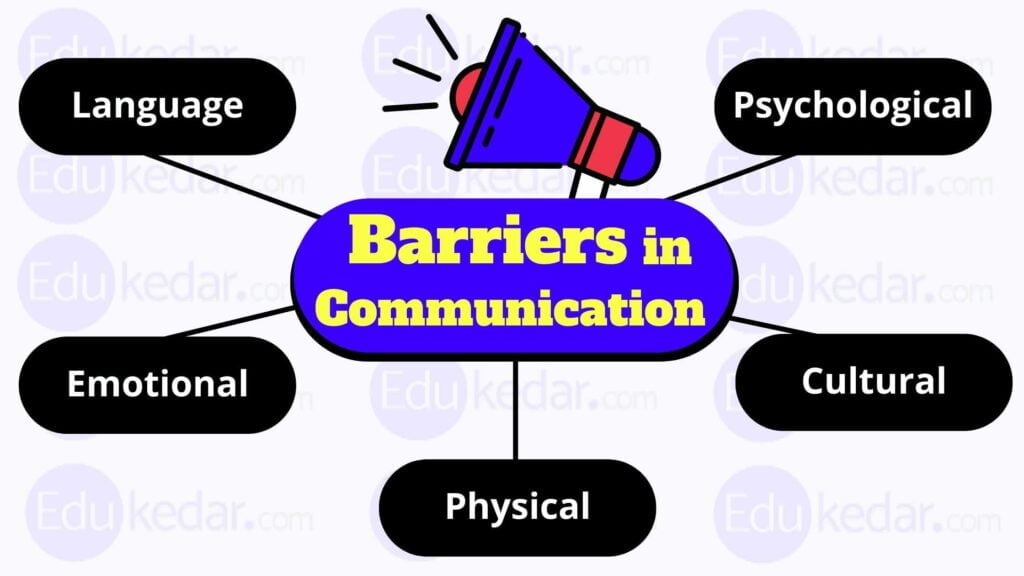
(2) Communicate According to the Need of the Receiver:
The sender of the communication should prepare the structure of the message not according to his own level or ability but he should keep in mind the level, understanding or the environment of the receiver.
- Consult Others before Communication: At the time of planning the communication, suggestions should be invited from all the persons concerned. Its main advantage will be that all those people who are consulted at the time of preparing the communication plan will contribute to the success of the communication system.
(4) Be Aware of Language, Tone and Content of Message:
The sender should take care of the fact that the message should be framed in clear and beautiful language. The tone of the message should not injure the feelings of the receiver. As far as possible the contents of the message should be brief and excessive use of technical words should be avoided.
(5) Convey Things of Help and Value to the Listener:
The subject matter of the message should be helpful to the receiver. The need and interest of the receiver should specially be kept in mind. Communication is more effective in such a situation
(6) Ensure Proper Feedback:
The purpose of feedback is to find out whether the receiver has properly understood the meaning of the information received. In the face-to- face communication, the reaction on the face of the receiver can be understood.
But in case of written communication or some other sort of communications some proper method of feedback should be adopted by the sender.
- Consistency of Message: The information sent to the receiver should not be self- contradictory. It should be in accordance with the objectives, policies, programmes and techniques of the organisation. When a new message has to be sent in place of the old one, it should always make a mention of the change otherwise it can create some doubts.
(8) Follow up Communication:
In order to make communication effective the management should regularly try to know the weaknesses of the communication system. In this context effort can be made to know whether to lay more stress upon the formal or the informal communication would be appropriate.
Similarly, suggestions can be invited in respect of the medium of communication (oral, written and gestural) to know as to which medium would be more effective and appropriate.
(9) Be a Good Listener:
It is the essence of communication that both the sender and the receiver should be good listeners. Both should listen to the each other‟s point of view with attention, patience and positive attitude. A sender can receive much relevant information by being a good listener.
UNIT-II
Public Speech: Com Position, Principles, Speech Delivering Skills, Group Discussion, Do‟s and Don‟t‟s of GD‟s Communication in Committees, Seminars and Conference.
Public Speaking
Public speaking (sometimes termed oratory or oration) is the process or act of performing a presentation (a speech) focused around an individual directly speaking to a live audience in a structured, deliberate manner in order to inform, influence, or entertain them. Public speaking is commonly understood as the formal, face-to-face talking of a single person to a group of listeners. Public speaking is the process of speaking to a group of people in a structured deliberate manner intended to inform, influence or entertain the listeners.
Basic Principles of Public Speaking
On order to make a successful presentation , a speaker should practice certain principles of good delivery.
- Look Natural:- If the presenter is stiff or artificial ,he/she will look uncomfortable and awkward. The audience may seer this as a lack of confidence, which might affect their perceptions of credibility. good speaker strives for a natural, easy going style of presentation.
- Maintain eye contact:-Make and maintain eye contact with the audience members often. This demonstrates confidence in the information being communicated to them, and engages them in discussion. Nervous eye-shifting and avoidance of eye contact will display anxiety that the audience will notice.
- Practice:-While we are humans and no one is perfect, consistently practising presentations will continuously improve public speaking skills. Speaking to a friend or a few colleagues is very different from commanding an audience of one hundred or one thousand people. The more you practice the better you will become, and the more comfortable you will be with public speaking.
- Do not read from Notes:-Reading from notes for any extended length of time takes the interest of audiences . although it is acceptable to glance at notes infrequently.Do not mumble. If you made an error, correct it and continue. No need to make excuses or apologize profusely.
- Speak with conviction:-If you rely believe in what you are saying. Persuade our audience effectively. The material you present orally should have the same ingredients as that which are required for a written research paper i.e. a logical progression from Introduction to Body to Conclusion.
- Pause:-Allow yourself and your audience a little time to reflect and think. Don‟t race through your presentation and leave your audience, well as yourself, feeling out of breath.
- Audio-visual aids:-There are many kinds of props which you may use for a successful presentation. This can be a good substitute for an introductory statement. This can also generate a more interesting approach to the audience .When using audio-visual aids to enhance your presentation, be sure all necessary equipment is set up and in good working order prior to the presentation.
- Speak, Listen, respond, Adjust and Adapt:-Speak to your audience, to their questions, respond to their reactions, adjust and adapt. Always be prepared for unexpected. If you are short of time, know what can be safely left out. If you have extra time, know what could be effectively added.
- Leave them with anticipation.:-When it comes to public speaking, less is more. Make your presentation a bit shorter than expected. Never allow your delivery to be so long that your audience wonders when it will be over. Make them wish you had spoken longer and gone further in depth on your topic.
- Inspire change:-Focus on the benefit you want to provide your listeners or the change you want to encourage them to make. Think about the following:
* What is the purpose for your presentation?
*What are you helping or motivating your audience to do?
*What are you teaching them?
*What goals are you helping them to achieve?
*What message do you want them to walk away from your presentation with?
GROUP DISCUSSION
Group discussion is commonly known as GD, as the name suggests, it is a group activity. People are grouped in a bunch for a common purpose:
- share knowledge
- exchange opinions
- brainstorm [find solutions innovative look for improvements]
- job selection process
It is a systematic purposeful interactive oral process. Here the members of the group share certain common objectives.
It is characterized by the formal and structural exchange of views on a particular topic / issue / problem.
Importance of GD:-
- GD is used as a technique for personality assessment of candidate for job selection or admission to professional courses.
- GD aims at problem solving, decision making and personality assessment
- Group of 6 – 8 members are formed and are given topic may be an opinion / a problem / a case.
- Members of the selection committee closely evaluate the different skills reflected by the candidates and those with leadership qualities emerge as natural leader/s are normally short listed.
Characteristics of Successful GD:-
- Agreement on group goal
- Goal oriented interaction
- Agreement on procedure
- Co-operative and friendly atmosphere
- Effective communication techniques
- Equitable distribution of participation
- Shared leadership
Areas of Evaluation in selection GDs:-
- Subject knowledge
- Oral communication skills
- Appropriateness of language
- Clarity of expression
- Non-verbal clues
- Leadership qualities – initiative, analysis, objectivity
- Team management – adaptability, positive attitude, co-operation
Key Points for GD:-
- Team spirit 5) Inspiring ability
- Reasoning ability 6) Awareness
- Leadership 7) Listening
- Creativity
Types of GDs: Broadly divided into two types:
- Concrete and fact-oriented topics, which need factual content in combination with the right perspective to be successful.
- Abstract topics where more than facts, you need interpretations and creative thinking. Here, the perspective from which the interpretation is made and the themes you build into them will be more significant and valuable.
Dos and Don’ts of participating in Group Discussion
As you have to participate in a Group Discussion. several questions spring across your mind. You want to know what actions and gestures can get you positive points and what can cost you the
selection. Here‟s a list of Dos and Don‟ts of participating in the GD.
Dos of participating in a GD:
- Listen to the subject carefully
- Put down your thoughts on a paper
- Initiate the discussion if you know the subject well
- Listen to others if you don‟t know the subject
- Support you point with some facts and figures
- Make short contribution of 25-30 seconds 3-4 times
- Give others a chance to speak
- Speak politely and pleasantly. Respect contribution from other members.
- Disagree politely and agree with what is right.
- Summarize the discussion if the group has not reached a conclusion.
Don’ts of participating in a Group Discussion
- Initiate the discussion if you do not have sufficient knowledge about the given topic.
- Over speak, intervene and snatch other‟s chance to speak.
- Argue and shout during the GD
- Look at the evaluators or a particular group member
- Talk irrelevant things and distract the discussion
- Pose negative body gestures like touching the nose, leaning back on the chair, knocking the table with a pen etc.
- Mention erratic statistics.
- Display low self confidence with shaky voice and trembling hands.
- Try to dominate the discussion
- Put others in an embarrassing situation by asking them to speak if they don‟t want.
SEMINAR
The word Seminar comes from the Latin word “Seminarium” which meant a breeding ground. The English word comes from the German word Seminar which meant a pupil group working/learning with a highly scholarly teacher.
Seminars are typically for training, but they also could be for
- A product promotion event
- A lecture on a particular topic
- A workshop where people learn hands-on
The seminar could range from a small group of people of just 4-5 members to a group as large as 100+ members.
The seminar could be free or paid.
Typical size of most educational seminars is 25 to 30 because it makes the speaker easier to disseminate the knowledge and engage with the attendees.
Seminars are also a fun and cost-effective way to gain knowledge on a particular topic at an accelerated pace.
A seminar is a form of academic instruction, either at an academic institution or offered by a commercial or professional organization. It has the function of bringing together small groups for recurring meetings, focusing each time on some particular subject, in which everyone present is requested to actively participate. This is often accomplished through an ongoing Socratic dialogue
with a seminar leader or instructor, or through a more formal presentation of research. It is essentially a place where assigned readings are discussed, questions can be raised and debates can be conducted.
It is relatively informal, at least compared to the lecture system of academic instruction.
Conference
A conference is generally understood as a meeting of several people to discuss a particular topic. It is often confused with a convention, colloquia or symposium. While a conference differs from the others in terms of size and purpose, the term can be used to cover the general concept. A convention is larger than a conference; it is a gathering of delegates representing several groups.
At a conference, innovative ideas are thrown about and new information is exchanged among experts. Its purpose could be one of the following:
- An academic conference is a gathering of scientists or academicians, where research findings are presented or a workshop is conducted.
- A business conference is held for people working in the same company or industry. They come together to discuss new trends and opportunities pertaining to the business
- A trade conference takes place on a larger scale. Besides businessmen, there are members of the public who come to network with vendors and made new connections. Such a conference consists of workshops and white paper presentations.
- An unconference differs from the traditional conference, since it avoids the high costs, top-down organizational hierarchy and sponsored presentations. All attendees are equally knowledgeable about the topic and the discussion follows an open mode; usually without a single speaker addressing the gathering.
Most conferences have one or more keynote speakers who will deliver the keynote speech. These are common at academic and business conferences. The speakers chosen are eminent personalities in the related field and their presence is meant to attract more people to attend the conference.
There are various types of conferences:
- A symposium is a casual gathering and includes refreshments and entertainment.
- A seminar is organized to discuss a particular topic. They are usually educational in nature and attendees are expected to gain new knowledge or skills at the end of the seminar
- A workshop is more of a hands-on experience for the participants with demonstrations and activities; the amount of time one speaker addresses the group is limited
- A round-table conference is a get-together of peers to exchange thoughts and opinions on a certain topic, usually political or commercial. There are a limited number of participants who sit at a round table, so that each one can face all the others
